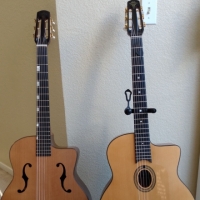DjangoBooks.com
Welcome to our Community!
Categories
- 17.9K All Categories
- 394 General
- 255 Welcome
- 10 Archtop Eddy's Corner
- 74 CD, DVD, and Concert Reviews
- 29 FAQ
- 9 Gypsy Jazz Italia
- 17 Photos
- 24 Gypsy Picking
- 3 Unaccompanied Django
- 1 Pearl Django Play-Along Vol.1
- 1 Gypsy Fire
- 21 Gypsy Rhythm
- 551 Gypsy Jazz University - Get Educated
- 104 Gypsy Jazz 101
- 175 Repertoire
- 128 History
- 88 Technique
- 39 Licks and Patterns
- Daniel Givone Manouche Guitare Method Users Group
- 17 Eddie Lang Club
- 997 Gypsy Jazz Gear
- 646 Guitars, Strings, Picks, Amps, Pickups and Other Accessories
- 315 Classifieds
- 36 Recording
- 38 Other Instruments
- 17 Violin
- 3 Mandolin
- 6 Accordion
- 3 Bass
- 9 Woodwinds
- 197 Gypsy Jazz Events
- 78 North America
- 81 Europe
- 38 International
In this Discussion
Bridge weight and dimensions
 Shawn
Boise, Idaho✭✭✭✭
Shawn
Boise, Idaho✭✭✭✭
Hi all, I've been experimenting over the last few months with different bridge designs and have some questions. I know each individual instrument is unique and tonally takes to different materials in many ways, but what is ideal for a bridge? I'm going to include some photos here of one of two bridges I've worked on, each made out of Rosewood, and each weighing in at only 4.5 grams. I know, in retrospective, this is extremely light for a bridge, but each guitar I've tested my bridges on have significantly increased in both volume and range of tonal colors. It got me to thinking if there is a certain weight that works best...in other words...is the lightest bridge possible the best or is too light not good either?
Anyhow, here are some pictures of one of the bridges (each bridge is identical, but one is currently now on one of my guitars). I've noticed that I can build them as tall as needed and it only increases their weight by around .5 grams. Basically, I took the Selmer (Dupont) bridge design and reduced any unneeded wood that isn't used to compensate and support the pressure from the strings and was able to get these bridges down to their 4.5 gram weight. The underside is extremely hollowed out and there is only minimal wood between the hollowed out underside and the top surface of the bridges.
Has anyone else experimented with this before?
Anyhow, here are some pictures of one of the bridges (each bridge is identical, but one is currently now on one of my guitars). I've noticed that I can build them as tall as needed and it only increases their weight by around .5 grams. Basically, I took the Selmer (Dupont) bridge design and reduced any unneeded wood that isn't used to compensate and support the pressure from the strings and was able to get these bridges down to their 4.5 gram weight. The underside is extremely hollowed out and there is only minimal wood between the hollowed out underside and the top surface of the bridges.
Has anyone else experimented with this before?










Comments
That doesn't necessarily mean the lightest bridge will have the balance one wants. In that area is part of the artistry of the luthier.
What tool did you use to hollow out the underside?
Thanks
I use a Dremel tool with a conical bit and free hand it. Once the initial groove is in, the bit tracks easily in the groove.
I'm actually working right now with what you could loosely call a prototype to see if I can get the weight down by another gram or two...I have some ideas which I think will significantly reduce the weight even more, and might even help the tonal characteristics. I won't know until it's complete and strung up, but I'm rather hopeful at this point. Basically, I'm trying to design one that will hold up under the string pressure almost to the point that it's going to collapse. So far, at 4.5 grams it actually sounds wonderful, but is far from the "collapse" point I'm trying to achieve.
I've had lots of luck messing with my bridges but the lightest I got to is about 8.5 grams.
I do notice I sometimes have a problem with one strings intonation and was wanting to understand how to make the proper compensation on the bridge. It seems like where the string should be there no material on the bridge.
Any help anyone?
pick on pickitjohn
what´s the main difference you´ve noticed with your light bridges, if i may ask? i tend not to like too light bridges, but my lightest was around 8-9 g... i hollowed it with just a narrow chisel, so i guess i could take some more wood if i used a dremel (which is actually a pretty good idea).
if you want to make them even lighter, use another wood : padauk is lighter than rosewood, stiff and has low damping - could be worth a try. walnut is another candidate.
best,
Miguel.
thanks
If you are just doing a few get the dremels.
Honduran rosewood resonates pretty well too.